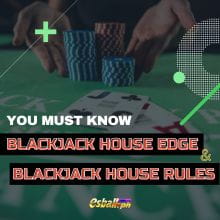Blackjack Probability Formula to Master Win Rates Over 75%
Blackjack. This seemingly simple game conceals profound principles of mathematics and probability. Now we will explore the Blackjack probability formula, unveiling the mathematical magic at this game.

Game Introduction
In the thrilling card game of Blackjack, there lies the subtle mathematics and mysteries of probability. Blackjack is a widely popular gambling game where the player's goal is to get a hand value as close to, but not exceeding, Blackjack. This seemingly simple game conceals profound principles of mathematics and probability. In this article, we will explore the Blackjack probability formula, unveiling the mathematical magic at this gaming table.

Blackjack Odds
- If we beat the dealer, the odds are 1 to 1 (winning one chip for every chip bet).
- If we beat the dealer with a Blackjack hand (without a tie), the odds are 3 to 2 (winning three chips for every two chips bet, or winning one and a half chips for every chip bet). In American Blackjack in Las Vegas, the odds are 6 to 5.
- If we win an insurance bet, the odds are 2 to 1 (winning two chips for every chip bet).
In American Blackjack, when a player's hand reaches Blackjack, and the dealer's face-up card is an Ace, the player receives a 2 to 1 payout instead of the usual 3 to 2 for achieving Blackjack.

Learn more Blackjack Strategy in our site.
Mathematical Perspective on Blackjack Odds
To delve into the mathematical perspective of learning Blackjack odds, we first need to understand that a standard deck of poker cards has 52 cards.
- Four of them are Aces.
- Sixteen are 10s or face cards.
- The remaining thirty-two are numerical cards from 2 to 9.
Thus, we can conclude that roughly one-third of the cards have a value of 10. Following this, there are only four Aces. So, if we aim for Blackjack, we need one of them. But what is the Blackjack Probability?
The probability of getting Blackjack refers to the number of ways to draw two cards from the entire deck and form Blackjack. In other words, it is the ratio of favorable events to possible events. Unlike odds, which are related but distinct, to get Blackjack, we need an Ace and a 10. There are four Aces and sixteen 10s (including face cards and numerical cards with a value of 10) in the whole deck.
On the other hand, all possible combinations of two cards refer to choosing two cards from the 52-card deck (order doesn't matter, and repetition is not allowed). Therefore, the final probability is: when playing with multiple decks, the proportion of face cards or numbers remains the same.
For example, with 4 Aces in 52 cards, there are 8 Aces in 104 cards. Although the ratio remains constant, the probability of obtaining a specific outcome may vary slightly. Removing one card from a deck of 104 has a minor impact on probability, while removing one card from a deck of 52 has a more noticeable effect. Hence, each game with a different number of decks has its own probability study.

Blackjack Probability of Player Over 21
To calculate the Blackjack Probability of going over 21, we need to analyze each hand scenario. Assuming a hand's total is 12, when drawing another card, we face 13 scenarios, out of which 4 scenarios may exceed Blackjack. Approximately 30% of the time, meaning for a hand with a point total of 12, the probability of going over Blackjack after drawing a card is 30%. Though this is a simplified calculation, in practice, slight adjustments should be made considering the impact of the cards forming the 12 points, but the difference is minor and complex to understand.
If we perform the same precise calculation for all possible hands, we get the following table: starting from 13, most of the time, both players and dealers will go over Blackjack. It's noteworthy that if the point total is 11 or lower, it's impossible to go over Blackjack with one card, so the probability is 0.
Learn more Blackjack Strategy in our site.
Blackjack Probability of Dealer Over 21
As mentioned earlier, to avoid losing bets in most cases, we need to draw another card when the hand's total is below 14. However, even if we limit it to 14 and below, do we have a chance to win? Considering that the dealer always draws until the point total reaches 17 or higher, only when the dealer goes over Blackjack can a player with a point total below 17 win.
In short, the dealer's hand total is always 17 or higher, so players with a total below 17 can only win if the dealer goes over Blackjack. According to mathematical research, the probability of the dealer going over Blackjack depends on the cards in hand (and their strategy), as follows:
- Higher-value cards have a lower probability of going over Blackjack, and Aces are the most favorable cards for the dealer.
- Lower-value cards, while having a higher probability, never exceed 50% in any case.
By averaging the calculations, we conclude that the dealer has a 28.35% chance of going over Blackjack (368.67/13). This means that in the remaining 71.65% of cases, if a player's hand total is below 17, they will lose the bet.

Dealer's Constraint
As we just saw, setting the constraint below the dealer's limit is futile because, in most cases, we will lose the bet. However, precisely because of this, we find that the dealer's face-up card provides valuable information for decision-making. Following this, we have the following questions:
- Why is the dealer's limit set at 17?
- What happens if I mimic the dealer's strategy and also stand at 17?
Learn more Blackjack Strategy in our site.
Dealer's Blackjack Probability Advantage
The dealer always waits for the player to finish their turn before starting their own. This means that if the player goes over Blackjack, regardless of the dealer's actions, the player will lose the bet. Even if the dealer also goes over Blackjack, the player still loses because they were eliminated earlier. This results in the dealer winning in situations that are essentially a draw, with a probability of about 7.9%. This represents a 8% advantage for the casino, considering that Blackjack pays 3 to 2 instead of a fair 2 to 1. This advantage is reduced to 5.6% in the end. To counteract this, players have various options such as doubling down, splitting, surrendering, etc., providing them with a flexible strategy. However, most importantly, players know one of the dealer's cards, influencing their decision-making, and once again, mathematics plays a role here.

 |
 |
Blackjack Strategy













